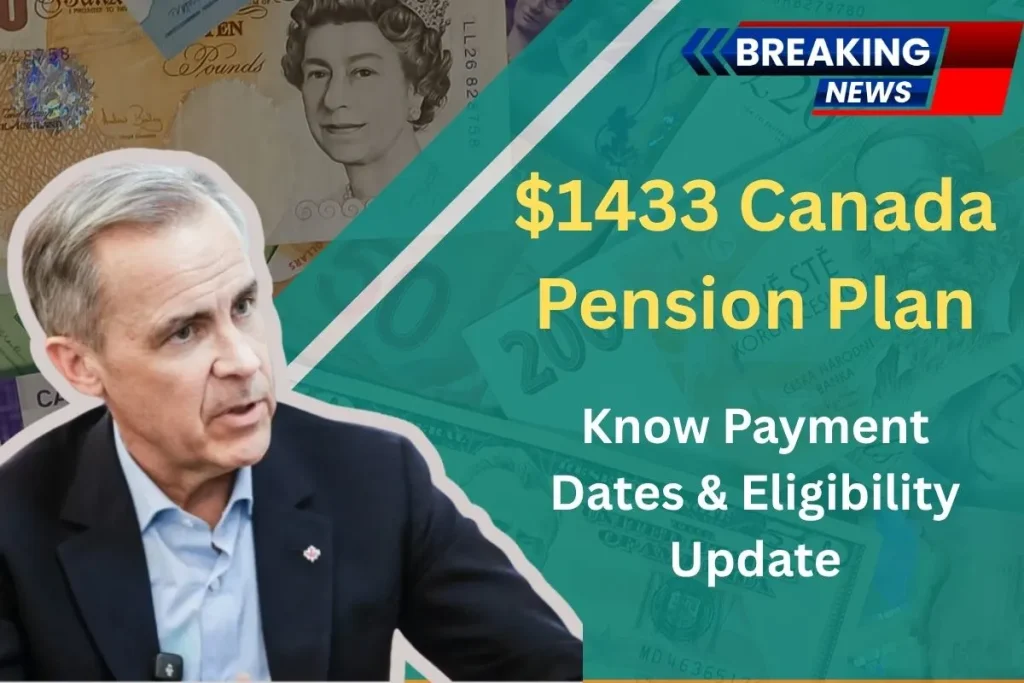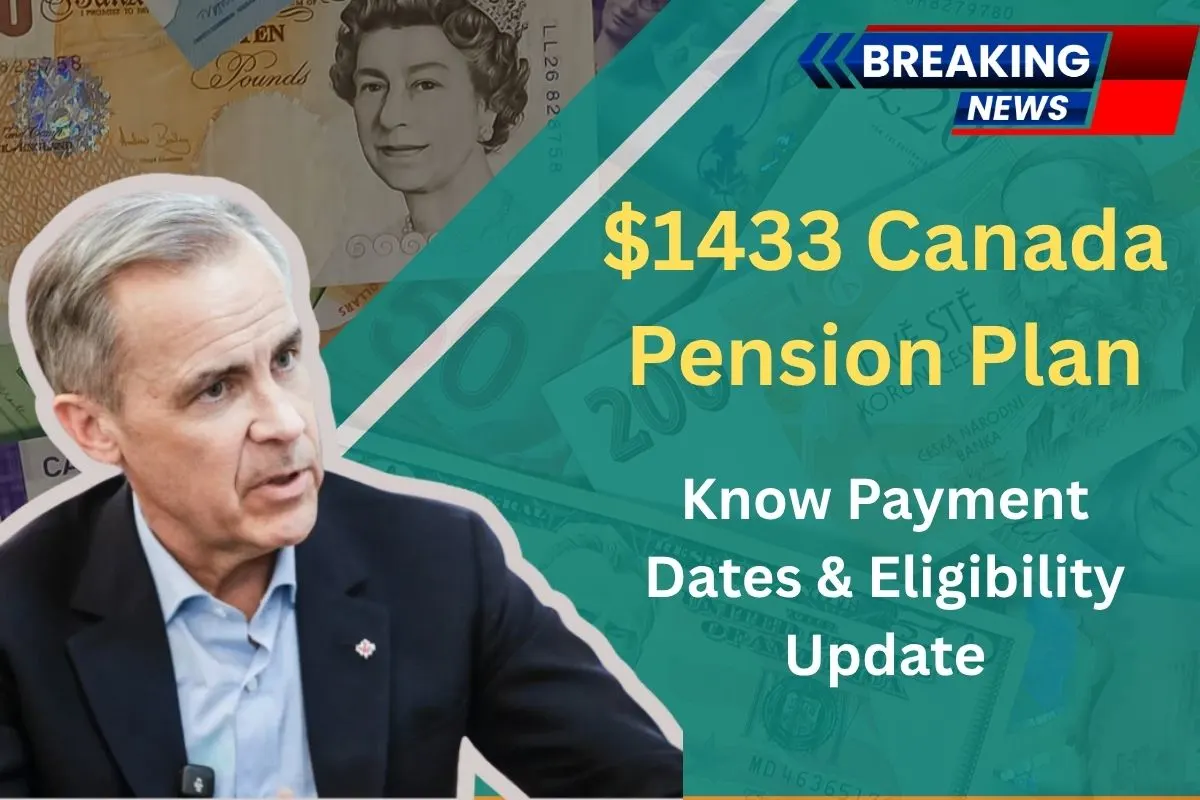The Canada Pension Plan is one of Canada’s most essential social security programs that provides crucial financial support to retirees in millions across the nation. With the maximum monthly amount rising to $1,433 in 2025 the CPP continues to be the foundation in retirement plans for Canadian employees. The increased benefit amount is a result of recent enhancements in the CPP program which include the expansion of contribution limits as well as increased earnings thresholds, which allow higher income contributors to make more contributions money and enjoy more benefits after retirement.
Knowing the current structure of payments as well as eligibility requirements and the dates for distribution are vital for Canadians thinking about their financial future, as well as people who are currently receiving benefits.
Understanding the $1433 Canada Pension Plan
The maximum monthly CPP payment is the most amount a person can get when they begin their retirement age of 65 by 2025. This amount includes both the basic CPP amount of $1,387 per month and the increased CPP amount of $46 a month which is a reflection of the program’s expansion to offer better security for retirement. To be eligible for this maximum amount, a person must have contributed the maximum CPP contributions for a minimum of 39 years, between the ages of 18 and 65. This makes this a difficult limit to meet.
The increased CPP component, which was introduced in recent reforms, allows greater contribution limits, and consequently more benefits. A Year’s Maximum Allowable Pensionable Earnings (YAMPE) to 2025 has been set at $81,200. That means CPP payments are mandatory on income between $71,300 to $81,200 at the rate of 4 percent. This is especially beneficial for higher-income earners, who are now able to contribute more towards their future retirement benefits.
$1433 Canada Pension Plan Overview
| Payment Details | 2025 Information |
| Maximum Monthly Payment | $1,433 |
| Moderate Amount | $800 to $1000 |
| Type of Payment | Monthly pension for retirement |
| Beneficiaries | Canadian retirees and seniors |
| Official Website | https://www.canada.ca/ |
| Minimum Age for Benefits | 60 years old |
| Standard Retirement Age | 65 years old |

2025 CPP Payment Schedule
CPP payments are disbursed monthly, on dates that are predetermined usually near the end of every month. In 2025, CPP beneficiaries are expected to receive their payouts on the following date 29 January, 26 February, 27 March, 28 April, 28 May, 26 June, 29 July, 27 August, 25 September, 29 October, 26 November and 22 December. These dates are set in the course of Service Canada and remain consistent throughout the year, which allows the beneficiaries to plan their financials in accordance with their needs.
The system of payment works through direct deposit into accounts in banks or through mail, which ensures timely delivery to any eligible recipient. If a payment date is a weekend or a holiday that is a statutory holiday, payment usually are issued on the day prior to the business day to prevent delays. Anyone who does not receive their payment as planned are advised to call Service Canada immediately for assistance in settling their account.
CPP Eligibility Requirements and Application Process
To be eligible to receive CPP pension benefits, applicants have to satisfy certain criteria set by federal authorities. The most important requirements are having at sixty years old, and having made a minimum of one contribution to the CPP throughout their active days. Contributions that are valid can be derived from work in Canada or from credits earned from a spouse or common-law spouse following separation or divorce.
The minimum retirement age to receive fully CPP benefit is age 65. However, the option of early retirement is available from age 60, with decreased monthly payment. However, Canadians can delay their CPP pension until they reach age 70 in order to enjoy higher monthly benefits. For those who work and receiving CPP the amount of their pension is not cut, but they could be eligible for additional Post-Retirement Benefits which will increase their monthly income.
Residents of Quebec are enrolled with Quebec’s Quebec Pension Plan (QPP) in lieu of CPP however, the two programs collaborate to ensure the same coverage for those who live in Quebec as well as other provinces. International workers are also eligible for CPP benefits under the social security agreements Canada has with other nations, which allow to combine pension benefits of several countries.
CPP Contribution Structure and Future Enhancements
CPP contribution system CPP contribution system is based in a two-tiered system for 2025, with various rates based on different income levels. The contribution rate for the base level remains at 5.95 percent for earnings up to $71,300. However, the increased amount of 4.4% is applicable to earnings between $71,300 and $81,200. Self-employed workers pay the employer and employee contributions which effectively double the amount they contribute.
The maximum contribution of the employer and employees for CPP to 2025 amounts $4,034.10 each, an increase over $3,867.50 in 2024. For those who earn above the threshold of increased earnings the additional contribution limit of $396 will be available, which is significantly higher than the $188 limit in 2024. The increased contributions will directly aid in the program’s expansion, and will lead to significantly higher retirement benefits for the future retirees.
With a look ahead In the future, in the future, CPP expansion is expected to provide dramatic improvements in retirement security. Following the complete implementation of modifications and forty years of contribution under the upgraded system the maximum CPP payment could rise to $25,277 a year in current dollars for people born after 2000. This represents a significant rise from the currently-in-force baseline CPP max of $16,645 a year and highlights the long-term advantages of the CPP’s growth.
CPP’s $1.433 maximum monthly payment in 2025 is a major achievement on the road to Canadian retirement security, highlighting continuous improvements that are that are designed to help those who are retiring as they reach their old age. With clearly-defined payment schedules and streamlined eligibility requirements and a broader range of contribution options as well, the CPP continues to grow as a key element to retirement plan for Canadian people. The CPP’s two-tiered system of contribution and higher earnings thresholds guarantee that those with higher incomes can enjoy more retirement benefits, while ensuring the accessibility of all Canadians.
Frequently Asked Questions
Q. Can I work when getting CPP benefit?
Yes, working while you receive CPP retirement benefits doesn’t decrease your pension benefits. If you’re younger than 70 and keep making CPP contributions even while you work you could qualify to receive an additional benefit, the CPP Post-Retirement Benefit. This benefit will provide you with additional income every month for the rest of your life. The benefit is calculated automatically and is paid in the year following the contributions you made, with no need for an application.
Q. How do retroactive CPP payments be handled?
If you are applying for CPP when you reach the age of age 65, Service Canada can provide retroactive payments as long as 12 months, which covers the 11 months preceding the application, plus the month of application. However, these retroactive benefits cannot be made prior to the month that follows your 65th birthday. Additionally, there are no retroactive benefits available in early retirement pensions received prior to age 65.
Q. What happens if I haven’t received my CPP payment by the due date?
CPP payments are usually deposited at the time of their scheduled date via direct deposit or by mail. If you do not receive the payment you expect, contact Service Canada immediately to investigate any issues that could be affecting your bank account, bank information or postal address. The payment process may sometimes be delayed because of banking holidays or administrative processes however Service Canada can provide specific information regarding your specific situation.
















